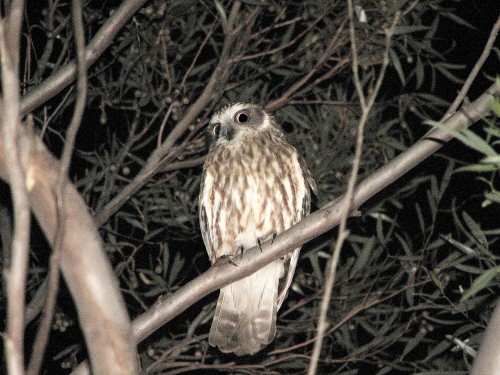A special night visitor
Last night we had a wonderful visitor to our garden. Just before we turned on the television we heard the unmistakeable call of a Southern Boobook Owl in our garden. I immediately grabbed a powerful torch and head outside. Unfortunately the bird not only stopped calling, it must have flown off. I searched a few of the trees where I thought that the sound had been coming from but to no avail. Never mind, it was good to hear it and know that this species is still around.
It was a special visitor because we are so infrequently aware of this species of owl in our garden or in our little patch of mallee scrub about 80km east of Adelaide, South Australia. We actually hear it only a few times a year – at best. I guess we should switch off the television more often. Or perhaps I should head off with a torch and walk the “estate” more often – all five acres of it!
Because the bird we heard last night did not hang around very long, there was no opportunity to grab the camera for a photo. The photo above – possibly the same bird – was taken in one of our trees a year or so ago. On that occasion the bird obligingly posed for two photos.
Update October 13th: we heard it again this evening. This time it was closer to the house and we had a good view of it – twice in a few days is special.
Other nocturnal birds
Below is a list of nocturnal birds I have recorded on our property. Click on each to go to articles and photos of them.
Southern Boobook Owl
Just as we were heading off to bed last night we heard a Southern Boobook Owl calling. It was calling persistently, even when I went up close to it with a torch. I raced back inside for the camera and managed two reasonable photos before it silently flew off again.
This owl species is wide spread throughout Australia where suitable habitat exists. Its call is familiar to many people but the bird is not as often seen. It has been quite a while since we last had one calling in our garden.
Other nocturnal species I have recorded in our garden over the years include:
- Barn Owl
- Australian Owlet-nightjar
- Spotted Nightjar
- Tawny Frogmouth
Southern Boobook Owl
Cold Night
Late last Saturday evening we were travelling back from visiting relatives in Jamestown in the mid-north of South Australia. It had been a lovely autumn day, clear sky, lovely sunshine and no wind. As soon as the sun set, the air had a sudden chill, as if a frost was settling in for the night. We saw the full moon rising soon after sunset.
Night Driving Hazards
As we travelled past the pine forests south of Jamestown I was on the alert for kangaroos on the road. Nephew Steve had warned me before we left to be on the alert as he had killed four roos in recent years in that area. When travelling rural South Australia I am always on the lookout, usually for sheep that have strayed through fences on to the road. Kangaroos and, in some parts, wombats, are very dangerous hazards on our roads, especially at night.
Wombats
Fortunately I had hit very few kangaroos, probably about five, in all my years of driving in Australia. I have never hit a sheep or cow and I never want to hit a wombat. It would be like hitting a rock, I’d imagine. I came close to one crossing the road one night near Swan Reach. Scary!
Owl
Now back to the bird sighting last Saturday night. At first I thought there was a rabbit sitting on the side of the road. As it flew off into the darkness I realised my mistake. At first I thought it was a Barn Owl, but the markings were all wrong; it was too dark. It had to be a Southern Boobook Owl, one of Australia’s most widespread and best known owls.
Its “boo-book” call is a familiar nocturnal sound throughout rural Australia. It is even heard in built up regions where suitable habitat exists. I have only heard it on one occasion near our home in Murray Bridge despite it being resident in the area. We have heard it far more often in Clare near my daughter’s home. It is a species more often heard than seen.
Update: I’ve just recorded it for the second time in our garden. To read about it click here. The article includes a photo. Posted on 4th May 2010


